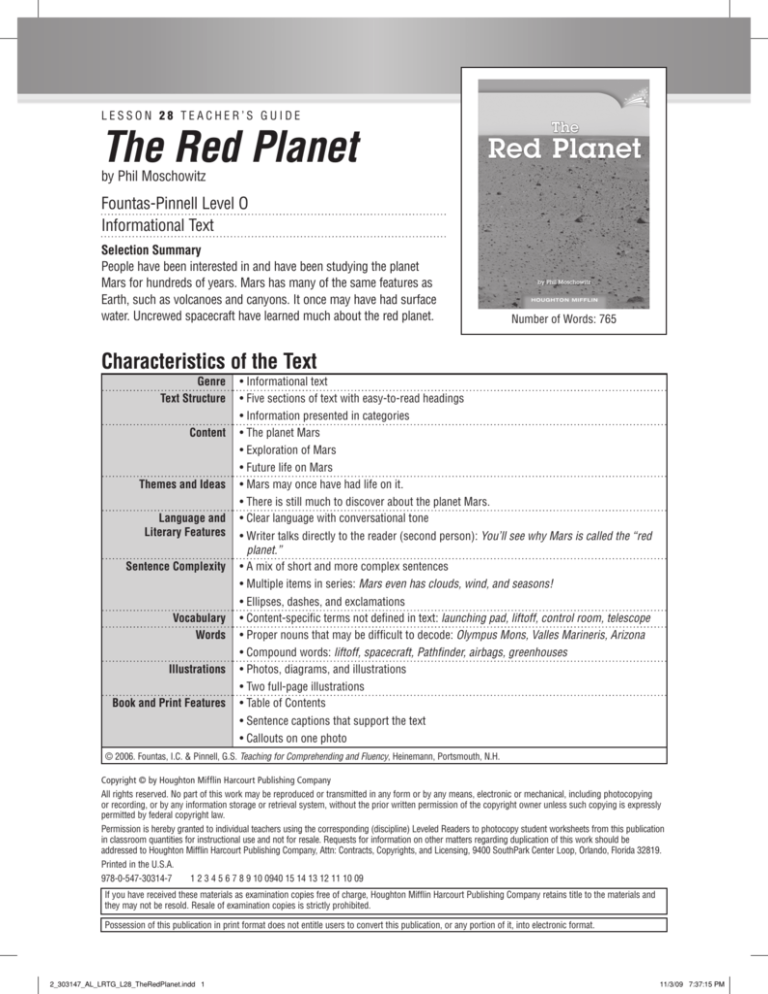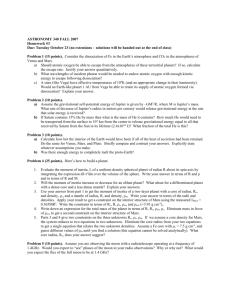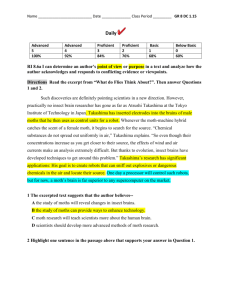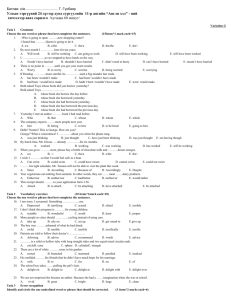
LESSON 28 TEACHER’S GUIDE
The Red Planet
by Phil Moschowitz
Fountas-Pinnell Level O
Informational Text
Selection Summary
People have been interested in and have been studying the planet
Mars for hundreds of years. Mars has many of the same features as
Earth, such as volcanoes and canyons. It once may have had surface
water. Uncrewed spacecraft have learned much about the red planet.
Number of Words: 765
Characteristics of the Text
Genre
Text Structure
Content
Themes and Ideas
Language and
Literary Features
Sentence Complexity
Vocabulary
Words
Illustrations
Book and Print Features
• Informational text
• Five sections of text with easy-to-read headings
• Information presented in categories
• The planet Mars
• Exploration of Mars
• Future life on Mars
• Mars may once have had life on it.
• There is still much to discover about the planet Mars.
• Clear language with conversational tone
• Writer talks directly to the reader (second person): You’ll see why Mars is called the “red
planet.”
• A mix of short and more complex sentences
• Multiple items in series: Mars even has clouds, wind, and seasons!
• Ellipses, dashes, and exclamations
• Content-specific terms not defined in text: launching pad, liftoff, control room, telescope
• Proper nouns that may be difficult to decode: Olympus Mons, Valles Marineris, Arizona
• Compound words: liftoff, spacecraft, Pathfinder, airbags, greenhouses
• Photos, diagrams, and illustrations
• Two full-page illustrations
• Table of Contents
• Sentence captions that support the text
• Callouts on one photo
© 2006. Fountas, I.C. & Pinnell, G.S. Teaching for Comprehending and Fluency, Heinemann, Portsmouth, N.H.
Copyright © by Houghton Mifflin Harcourt Publishing Company
All rights reserved. No part of this work may be reproduced or transmitted in any form or by any means, electronic or mechanical, including photocopying
or recording, or by any information storage or retrieval system, without the prior written permission of the copyright owner unless such copying is expressly
permitted by federal copyright law.
Permission is hereby granted to individual teachers using the corresponding (discipline) Leveled Readers to photocopy student worksheets from this publication
in classroom quantities for instructional use and not for resale. Requests for information on other matters regarding duplication of this work should be
addressed to Houghton Mifflin Harcourt Publishing Company, Attn: Contracts, Copyrights, and Licensing, 9400 SouthPark Center Loop, Orlando, Florida 32819.
Printed in the U.S.A.
978-0-547-30314-7
1 2 3 4 5 6 7 8 9 10 0940 15 14 13 12 11 10 09
If you have received these materials as examination copies free of charge, Houghton Mifflin Harcourt Publishing Company retains title to the materials and
they may not be resold. Resale of examination copies is strictly prohibited.
Possession of this publication in print format does not entitle users to convert this publication, or any portion of it, into electronic format.
2_303147_AL_LRTG_L28_TheRedPlanet.indd 1
11/3/09 7:37:15 PM
The Red Planet
by Phil Moschowitz
Build Background
Help children use their knowledge of the solar system and planets to visualize the book.
Read the title and author and talk about the cover illustration. Ask: Do you know which
planet is the red planet? What does the surface of the planet look like on the cover? Tell
children that this book gives factual information about one of our neighbors in space, the
planet Mars.
Introduce the Text
Guide children through the text, noting important ideas, and helping with unfamiliar
language and vocabulary. Here are some suggestions:
Page 2: Remind children that a table of contents provides a preview of a book by
listing its different sections and the pages on which they start.
Suggested language: Turn to page 2 of this book. What is the first section listed in
the Table of Contents? What is a liftoff? What kinds of vehicles lift off?
Page 3: Read aloud the first sentence: The rocket waits on the launching pad as
scientists check and recheck the instruments. Why do you think scientists have
to recheck the instruments? What kinds of information might the instruments tell
the scientists?
Page 5: Point out that the diagram shows the planets in our solar system. Earth is
the third planet from the sun. Which is the fourth planet?
Pages 8–9: Explain that the diagram on page 9 shows how a parachute helped
a spacecraft land safely on Mars. Some people jump from planes wearing
parachutes, to help them land safely. This parachute held up the Mars rover, a
vehicle that explored Mars. The vehicle rolled around the red planet and sent back
information to scientists on Earth.
Now turn back to the beginning of the book and read to find out how scientists
have explored the planet Mars and what they have learned about it.
Expand Your Vocabulary
evidence – something that gives
proof of the truth, p. 10
inflated – swelled or filled with
air or gas, p. 8
Grade 2
instruments – tools designed
especially for precision work,
p. 3
mission – a task or job that is
assigned, p. 10
2
parachute – a folding, umbrellashaped device of light fabric
used especially for making a
safe jump from an aircraft, p. 8
vehicle – something used to
transport people or goods, p. 8
Lesson 28: The Red Planet
© Houghton Mifflin Harcourt Publishing Company
2_303147_AL_LRTG_L28_TheRedPlanet.indd 2
7/30/09 8:13:35 AM
Read
Have children read The Red Planet silently while you listen to individual children read.
Support their problem solving and fluency as needed.
Remind children to use the Analyze/Evaluate Strategy
they feel about the text and why.
, and to tell how
Discuss and Revisit the Text
Personal Response
Invite children to share their personal responses to the book.
Suggested language: Have you ever wanted to explore another planet, like Mars? Why or
why not?
Ways of Thinking
As you discuss the text, help children understand these points:
Thinking Within the Text
Thinking Beyond the Text
Thinking About the Text
• Like Earth, the planet Mars has
ice caps, clouds, winds, and
seasons.
• Because Mars may once have
had surface water, life may have
existed there.
• The section headings give
information about what each
section will contain.
• Spacecraft sent to Mars have
sent back much information on
the red planet.
• Spacecraft have provided a great
deal of information about Mars,
but there is still much to be
learned about the planet.
• The photos and illustrations add
to the information in the text.
• No signs of life have been found
on Mars, but life might have
existed there long ago.
• The author includes lots of
details about the exploration of
Mars.
• The author’s attitude towards
space exploration is very
positive.
© 2006. Fountas, I.C. & Pinnell, G.S. Teaching for Comprehending and Fluency, Heinemann, Portsmouth, N.H.
Choices for Further Support
• Fluency Invite children to choose a passage from the text and demonstrate phrased
fluent reading. Remind them to group words in a meaningful way to show that they
understand what they are reading.
• Comprehension Based on your observations of the children’s reading and discussion,
revisit parts of the text to clarify or extend comprehension. Remind children to go
back to the text to support their ideas.
• Phonics/Word Work Provide practice as needed with words and word parts, using
examples from the text. Remind children that a prefix at the beginning of a word can
change the meaning of a word they know. Point out the words check and recheck in
the first sentence on page 3. Explain that the prefix re- adds the meaning “again” to a
word. To recheck something is to check it again. Have children find another word with
re- in the book (research on page 10).
Grade 2
3
Lesson 28: The Red Planet
© Houghton Mifflin Harcourt Publishing Company
2_303147_AL_LRTG_L28_TheRedPlanet.indd 3
11/3/09 7:37:22 PM
Writing about Reading
Critical Thinking
Have children complete the Critical Thinking questions on BLM 28.9.
Responding
Have children complete the activities at the back of the book. Use the instruction below as
needed to reinforce or extend understanding of the comprehension skill.
Target Comprehension Skill
Text and Graphic Features
Remind children that photos and diagrams can
help them understand the book. Model the skill, using a “Think Aloud” like the one below:
Think Aloud
On page 7, the text tells about the Viking spacecraft. The caption with the
photo on the page tells you how many pictures Viking spacecraft sent
back. The photo shows just what the Viking spacecraft looked like when it
was on Mars. The photo, caption, and the text work together to give you
information and help you understand what you are reading.
Practice the Skill
Have children find another example in the book where the photo and text work together to
give readers information.
Writing Prompt: Thinking Beyond the Text
Have children write a response to the prompt on page 6. Remind them that when they
think beyond the text, they use what they know and their own experience to think about
what happens in the story.
Assessment Prompts
• What does the word mission mean in this sentence: “These two rovers had the same
mission—to find proof that there was once water on Mars”?
• What helped Pathfinder land safely on Mars?
Grade 2
4
Lesson 28: The Red Planet
© Houghton Mifflin Harcourt Publishing Company
2_303147_AL_LRTG_L28_TheRedPlanet.indd 4
11/3/09 7:37:27 PM
English Language Development
Reading Support In Introduce the Text, use pictures, concrete objects, or
demonstrations that will help children understand the concepts and ideas in the text. Don’t
ask children to read any text they will not understand.
Vocabulary Offer children support with unfamiliar technology words and terms such as
launching pad, spacecraft, control room, computers, telescope, volcano, and television.
Oral Language Development
Check children’s comprehension, using a dialogue that best matches their
English proficiency level. Speaker 1 is the teacher, Speaker 2 is the child.
Beginning/Early Intermediate
Intermediate
Early Advanced/ Advanced
Speaker 1: What is the name of the red
planet?
Speaker 1: What did the spacecraft
Pathfinder study on Mars?
Speaker 2: Mars
Speaker 2: It studied dirt and rocks.
Speaker 1: Why would scientists
want to build giant greenhouses
on Mars?
Speaker 1: Why is Mars called the red
planet?
Speaker 1: What did the two rovers try
to prove about Mars?
Speaker 2: It looks red in space.
Speaker 2: They tried to prove that there
was once water on Mars.
Speaker 2: Humans can’t breathe
on Mars. The plants in the
greenhouses would provide fresh
air for humans to breathe.
Lesson 28
Name
Date
BLACKLINE MASTER 28.9
Think About It
The Red Planet
Think About It
Read and answer the questions.
1. Why is Mars called the “red planet”?
*UPGUFOMPPLTSFEJOUIFTLZ
2. How are Mars and Earth alike?
5IFZCPUIPSCJUBSPVOEUIF4VOBOEIBWFJDFDBQTDMPVET
XJOETTFBTPOTDBOZPOTBOEWPMDBOPFT
3. How does the drawing on page 5 help you
understand what you are reading?
1PTTJCMFSFTQPOTF5IFQJDUVSFIFMQTNFTFFXIFSF.BST
&BSUIBOEUIF4VOBSF
Making Connections Imagine you wanted to learn more about
Mars. Where would you go to get information? Why?
Write your answer in your Reader’s Notebook.
Read directions to children.
Think About It
Grade 2, Unit 6: What a Surprise!
¥)PVHIUPO.JGGMJO)BSDPVSU1VCMJTIJOH$PNQBOZ"MMSJHIUTSFTFSWFE
Grade 2
5
Lesson 28: The Red Planet
© Houghton Mifflin Harcourt Publishing Company
2_303147_AL_LRTG_L28_TheRedPlanet.indd 5
7/30/09 8:13:37 AM
Name
Date
The Red Planet
Thinking Beyond the Text
Think about the questions below. Then write your answer in one or two
paragraphs.
Someday there might be sightseeing trips to Mars. Would you buy a ticket
on a rocket ship to Mars? Why or why not?
Grade 2
6
Lesson 28: The Red Planet
© Houghton Mifflin Harcourt Publishing Company
2_303147_AL_LRTG_L28_TheRedPlanet.indd 6
7/30/09 8:13:38 AM
Lesson 28
Name
Date
BLACKLINE MASTER 28.9
Think About It
The Red Planet
Think About It
Read and answer the questions.
1. Why is Mars called the “red planet”?
2. How are Mars and Earth alike?
3. How does the drawing on page 5 help you
understand what you are reading?
Making Connections Imagine you wanted to learn more about
Mars. Where would you go to get information? Why?
Write your answer in your Reader’s Notebook.
Grade 2
7
Lesson 28: The Red Planet
© Houghton Mifflin Harcourt Publishing Company
2_303147_AL_LRTG_L28_TheRedPlanet.indd 7
11/3/09 7:39:15 PM
Student
Lesson 28
Date
BLACKLINE MASTER 28.13
The Red Planet • LEVEL O
page
5
The Red Planet
Running Record Form
Selection Text
Errors
Self-Corrections
Accuracy Rate
Total SelfCorrections
Scientists have been studying Mars for a long
time. They know Mars is like Earth in many
ways. Scientists know Mars orbits, or travels
around, the sun, like Earth and the other planets
do. Mars also has ice caps just like Earth. Mars
even has clouds, wind, and seasons!
6
Mars has volcanoes, too. The tallest volcano
on Mars is called Olympus Mons. Olympus Mons
is 13 miles high! The tallest volcano on Earth isn’t
even 6 miles high.
Mars has deep canyons, too. They are much
deeper than the canyons on Earth. The Grand
Canyon in Arizona is a little more than a mile deep.
Comments:
(# words read
correctly/105 × 100)
%
Read word correctly
Code
✓
cat
Repeated word,
sentence, or phrase
®
Omission
—
cat
cat
Grade 2
Behavior
Error
0
0
1
8
Substitution
Code
cut
cat
1
Self-corrects
cut sc
cat
0
Insertion
the
1
Word told
T
cat
cat
Error
1413650
Behavior
1
Lesson 28: The Red Planet
© Houghton Mifflin Harcourt Publishing Company
2_303147_AL_LRTG_L28_TheRedPlanet.indd 8
12/8/09 2:24:35 PM








